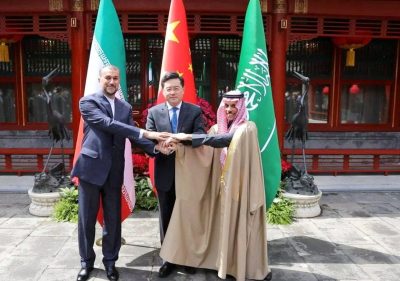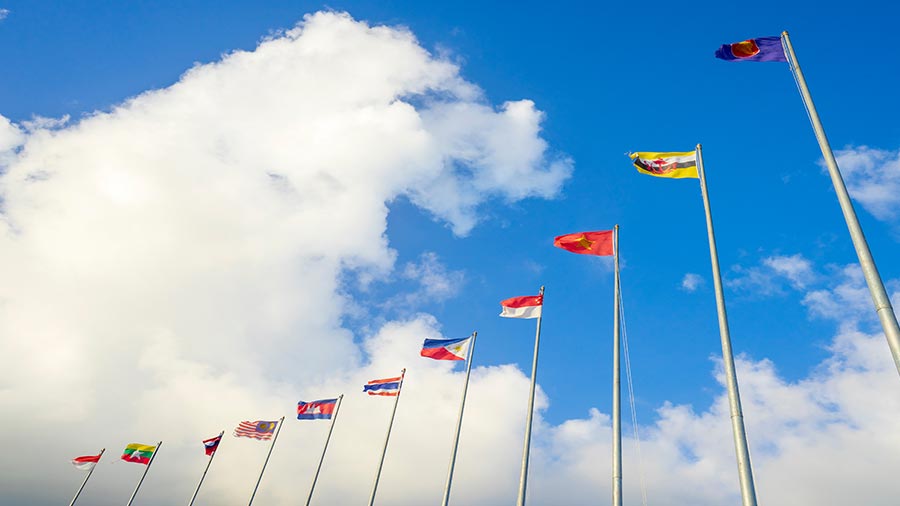China
Why the Saudi–Iran agreement doesn’t herald an active role for China in the Gulf

Author: Guy Burton, Brussels School of Governance
In March 2023, Iran and Saudi Arabia agreed to re-establish diplomatic relations, with China playing a role as the host of the talks. This generated considerable discussion among policymakers and the scholarly community. Some believed this indicated a new change in China’s approach to the Middle East, which has primarily focused on commercial relations.
But the assumption that China is about to take on a more prominent and active role as a conflict mediator in the Gulf region is overstated. Although Beijing hosted the talks that led to the agreement, much of the substantive work had been done earlier, primarily by Iraq and Oman. China’s late involvement was also enabled because the United States does not have relations with Iran, making it difficult for the United States to broker a deal.
China’s participation was like its earlier efforts at regional conflict management. Between 2004–07 it tried to bridge the gap between the international community and the Sudanese regime during the Darfur crisis. Beijing then did something similar in 2013–15 between the West and Iran over the Iranian nuclear program, culminating in the Joint Comprehensive Plan of Action. In both cases, Chinese involvement was helped by a pre-established framework of dialogue and the willingness of each side to involve Beijing.
Discussion since the Saudi–Iran agreement has moved on to how China might guarantee relations between the two rivals. This makes too much of the agreement, which was limited to restarting diplomatic ties. Even if China had the will, it lacks the capacity to impose itself on the two signatories, not least because several grievances persist between them. They include Iran’s creeping nuclear militarisation and their contrary stances over the civil war in Yemen — though there are signs that the two sides may be starting to find some common ground.
Even if China cannot ensure future stability, there are sufficient incentives from within the region that might make this possible. Iran and Saudi Arabia had good reasons to reach an agreement with each other. On the Saudi side, there is a sense that Washington has become less reliable. At the same time, Riyadh realises that diversifying relations is no bad thing — Saudi Arabia’s commercial ties have grown substantially with China over the past two decades. Between 2005 to 2022, Chinese investments in Saudi Arabia totalled US$12.78 billion compared to US$4.72 billion in Iran.
Meanwhile, Iran is struggling economically. Between 2012 and 2021 its GDP almost halved, from US$644 billion to US$360 billion, exacerbated by sanctions. It also faced widespread protests against the killing of Mahsa Amini in police custody in 2022, prompting it to crack down on protestors. Compared to the Saudis, Iran has fewer available alternatives. Although it signed an investment contract with China two years ago, there has been little sign that it has led to any substantial increase in resources. Having China host diplomatic talks with the Saudis may have been Iran’s way of staying in Beijing’s line of sight.
The agreement from both sides to involve China will potentially reduce part of the Gulf rivalry while also indicating that China may be becoming aware that its growing economic profile brings with it political implications. China has long sought to avoid becoming entangled in regional tensions and conflicts. But that is proving harder than it seems. Following the Gulf Cooperation Council (GCC) summit with China in December 2022, a joint declaration reiterated the GCC’s long-standing support for the United Arab Emirates’ claims over the Tunb and Abu Musa islands. Tehran also claims these islands and summoned the Chinese ambassador post-announcement.
The Chinese now appear more attentive towards tensions in the Gulf. On the eve of his visit to the Gulf in 2021, then foreign minister Wang Yi published China’s Five-Point Plan. It referred to the need for collective and regionally generated security in the Gulf. Wang pointed to the need for a ‘trust mechanism’ along with ‘safety for oil facilities and shipping lanes’.
While it is notable that China was involved in the final stages of the reestablishment of diplomatic relations between Saudi Arabia and Iran, it is important not to exaggerate either the nature of the agreement nor China’s role in the region. Other regional conflicts, like those in Syria, Israel–Palestine, Libya or Yemen are likely to remain beyond Chinese intervention.
So long as conflicting…
Business
Gordonstoun Severs Connections with Business Led by Individual Accused of Espionage for China

Gordonstoun school severed ties with Hampton Group over espionage allegations against chairman Yang Tengbo. He denies involvement and claims to be a victim of political tensions between the UK and China.
Allegations Lead to School’s Decision
Gordonstoun School in Moray has cut ties with Hampton Group International after serious allegations surfaced regarding its chairman, Yang Tengbo, who is accused of being a spy for the Chinese government. Known by the alias "H6," Mr. Tengbo was involved in a deal that aimed to establish five new schools in China affiliated with Gordonstoun. However, the recent allegations compelled the school to terminate their agreement.
Public Denial and Legal Action
In response to the spying claims, Mr. Tengbo publicly revealed his identity, asserting that he has committed no wrongdoing. A close associate of Prince Andrew and a former Gordonstoun student himself, Mr. Tengbo has strenuously denied the accusations, stating that he is a target of the escalating tensions between the UK and China. He has claimed that his mistreatment is politically motivated.
Immigration Challenges and Legal Responses
Yang Tengbo, also known as Chris Yang, has faced additional challenges regarding his immigration status in the UK. After losing an appeal against a ban enacted last year, he reiterated his innocence, condemning media speculation while emphasizing his commitment to clear his name. Gordonstoun, on its part, stated its inability to divulge further details due to legal constraints.
Source : Gordonstoun cuts ties with business chaired by man accused of spying for China
Business
China Dismantles Prominent Uyghur Business Landmark in Xinjiang – Shia Waves

The Chinese government demolished the Rebiya Kadeer Trade Center in Xinjiang, affecting Uyghur culture and commerce, prompting criticism from activists amid concerns over cultural erasure and human rights violations.
Demolition of a Cultural Landmark
The Chinese government recently demolished the Rebiya Kadeer Trade Center in Urumqi, Xinjiang, a vital hub for Uyghur culture and commerce, as reported by VOA. This center, once inhabited by more than 800 predominantly Uyghur-owned businesses, has been deserted since 2009. Authorities forcibly ordered local business owners to vacate the premises before proceeding with the demolition, which took place without any public notice.
Condemnation from Activists
Uyghur rights activists have condemned this demolition, perceiving it as part of China’s broader strategy to undermine Uyghur identity and heritage. The event has sparked heightened international concern regarding China’s policies in Xinjiang, which have been characterized by allegations of mass detentions and cultural suppression, prompting claims of crimes against humanity.
Rebiya Kadeer’s Response
Rebiya Kadeer, the center’s namesake and a notable Uyghur rights advocate, criticized the demolition as a deliberate attempt to erase her legacy. Kadeer, who has been living in exile in the U.S. since her release from imprisonment in 2005, continues to advocate for Uyghur rights. She has expressed that her family members have suffered persecution due to her activism, while the Chinese government has yet to comment on the legal ramifications of the demolition.
Source : China Demolishes Uyghur Business Landmark in Xinjiang – Shia Waves
China
China Expands Nationwide Private Pension Scheme After Two-Year Pilot Program

China’s private pension scheme, previously piloted in 36 cities, will roll out nationwide on December 15, 2024, enabling workers to open tax-deferred accounts. The initiative aims to enhance retirement savings, address aging population challenges, and stimulate financial sector growth.
After a two-year pilot program, China has officially expanded its private pension scheme nationwide. Starting December 15, 2024, workers covered by urban employee basic pension insurance or urban-rural resident basic pension insurance across the country can participate in this supplementary pension scheme. This nationwide rollout represents a significant milestone in China’s efforts to build a comprehensive pension system, addressing the challenges of a rapidly aging population.
On December 12, 2024, the Ministry of Human Resources and Social Security, together with four other departments including the Ministry of Finance, the State Taxation Administration, the Financial Regulatory Administration, and the China Securities Regulatory Commission, announced the nationwide implementation of China’s private pension scheme effective December 15, 2024. The initiative extends eligibility to all workers enrolled in urban employee basic pension insurance or urban-rural resident basic pension insurance.
A notable development is the expansion of tax incentives for private pensions, previously limited to pilot cities, to a national scale. Participants can now enjoy these benefits across China, with government agencies collaborating to ensure seamless implementation and to encourage broad participation through these enhanced incentives.
China first introduced its private pension scheme in November 2022 as a pilot program covering 36 cities and regions, including major hubs like Beijing, Shanghai, Guangzhou, Xi’an, and Chengdu. Under the program, individuals were allowed to open tax-deferred private pension accounts, contributing up to RMB 12,000 (approximately $1,654) annually to invest in a range of retirement products such as bank deposits, mutual funds, commercial pension insurance, and wealth management products.
Read more about China’s private pension pilot program launched two years ago: China Officially Launches New Private Pension Scheme – Who Can Take Part?
The nationwide implementation underscores the Chinese government’s commitment to addressing demographic challenges and promoting economic resilience. By providing tax advantages and expanding access, the scheme aims to incentivize long-term savings and foster greater participation in personal retirement planning.
The reform is expected to catalyze growth in China’s financial and insurance sectors while offering individuals a reliable mechanism to enhance their retirement security.
| This article was first published by China Briefing , which is produced by Dezan Shira & Associates. The firm assists foreign investors throughout Asia from offices across the world, including in in China, Hong Kong, Vietnam, Singapore, and India . Readers may write to info@dezshira.com for more support. |
Read the rest of the original article.






